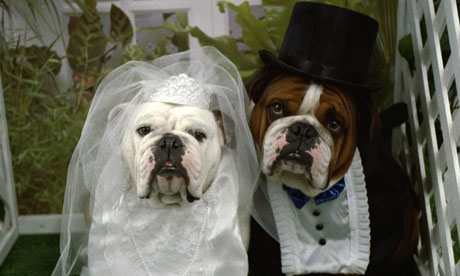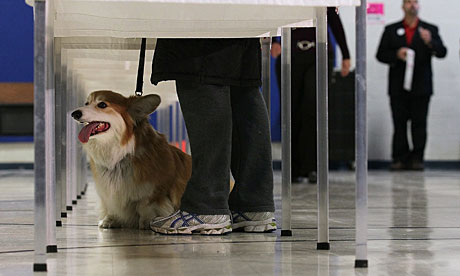 |
On her return home after helping rescue earthquake victims in Indonesia, British border collie Darcy had to spend six months in a quarantine cell
Essex County Fire and Rescue Service
|
After a 7.6 earthquake struck Indonesia in 2009, a British search-and-rescue dog named Darcy traveled with her handler to search for survivors in a remote Sumatran village. When she returned to the U.K., instead of a hero's welcome, the perky border collie faced six months in a 3x6.5-foot concrete pen — a prisoner of the U.K.'s strict quarantine rules for pets coming into the country.
It's a bad memory for Darcy's handler, John Ball of the U.K. International Search and Rescue team. "No rescue dog should have to go through the trauma of being locked away simply because they've been part of a rescue effort in a foreign country," says Ball. But come Jan. 1, no dog will ever face Darcy's quarantine ordeal again. After almost two decades of campaigning by animal lovers, the U.K. is easing its notoriously strict rules for pets coming into the country by abolishing quarantine and slashing waiting times for the furry friends scratching at Britain's door.
(See the top 10 animal stories of 2011.)
Pet owners hoping to enter the British Isles have long argued that the U.K.'s quarantine laws — introduced in 1897, before vaccines were invented, to protect from the threat of rabies – are unnecessary and cruel. According to the U.K. Department for Environment, Food and Rural Affairs, there has been only one recorded case of rabies in British quarantine kennels since the 1970s. Finally, it seems, the British government has agreed. "The U.K.'s quarantine system was designed to combat the threat of rabies in the 19th century and has now been left far behind scientific advances," environment secretary Caroline Spelman acknowledged in a statement announcing the less stringent rulesover the summer. "It's time we changed these outdated rules which have caused hardship to generations of pets and pet owners."
The change is the second of two hard-won victories for pets visiting, returning to or re-locating to the U.K. The first was the abolition, in 2000, of mandatory six-month quarantine upon arrival for dogs, cats and ferrets. Robbed of exercise and contact with their owners, many quarantined animals suffered and several died in conditions their owners likened to "jail" and "solitary confinement." When her healthy 7-year-old beagle Bertie passed away shortly after emerging from his six months, Lady Mary Fretwell — the wife of the then British ambassador to France — launched a campaign in 1994 called Passports for Pets. She attracted fervent supporters in the highest echelons of British society, including the late Harold Harmsworth aka Viscount Rothermere. As owner of the The Daily Mail, Harmsworth offered to throw his influential tabloid's support behind a young candidate for Prime Minister, Tony Blair, if he would change the rules so that Harmsworth could travel with his beloved pup.
By February 2000, Blair was leading the country and the old quarantine rules had been replaced by a passport program (PETS) that allowed pets to travel more easily between the E.U. and other qualifying countries like the U.S., Japan and Australia. It wasn't perfect — pet owners still had to wait six months after a rabies vaccine before bringing their animals into Britain — but at least they weren't forced to put them in quarantine, and could wait with their pets in comfort in another country.
(Watch "Rescued Stray Becomes a Therapist.")
For rescue dogs like Darcy, however, there was a hitch. Animals that had been in countries outside the PETS program — including South Africa, Brazil and India — still had to go into quarantine, even if they had been vaccinated against rabies before they went to that country.
The new rules that begin on Jan. 1 will make it easier for all pets, wherever they're traveling from. In the New Year, there will be no more required quarantine for any rabies-vaccinated pets. In addition, waiting times will be shortened from six months to three weeks for vaccinated animals from PETS countries, and to three months from other countries.
The change won't just benefit diplomats' pampered pooches and rescue dogs; it will also help dogs that need rescuing. Chrissy Phillips, a Brit who founded the U.K. non-profit Romania Animal Aid in 2008, says that until now matching stray dogs in Eastern Europe with eager U.K. homes was expensive and difficult. "You have the problem of where to keep them safe for six months out there while they're waiting for their pet passports to become valid," she says. "[The change] is a big relief to people trying to help these animals from overseas."
(Watch "How Dogs Help Veterans Cope with PTSD.")
The shorter three-week wait means rescue groups like Romania Animal Aid can afford to house more rescue dogs until they come to the U.K. to find loving families. For families unwilling to consider adopting a pit bull — the breed that now dominates U.K. shelters – an animal from abroad is an attractive alternative to buying a puppy from a breeder. "They're very cute, archetypal, happy little waggy-tailed dogs," Phillips says of the strays wandering the streets of Budapest.
The rule change will save the lives of many stray dogs — and perhaps also the lives of a few humans. Search-and-rescue handler Ball is thrilled to know that he'll be able to take Darcy abroad again. "We always said we'd do [only] one mission as long as we had quarantine, and hopefully it might change in the future," he says. Now that the rule is changing, he and Darcy can do the work they've trained for. "It's a huge step forward."
Article by
SONIA VAN GILDER COOKE / LONDON
For
Time World























